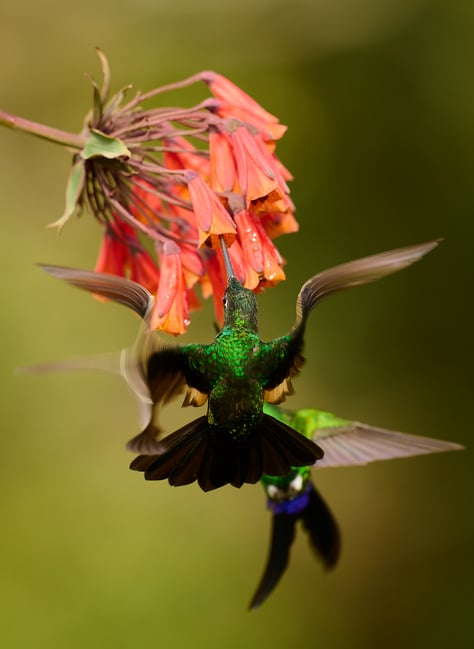Maybe it’s happened to you, too – and not necessarily in photography. Perhaps you accidentally put an ingredient in your soup, or meant to pass the ball but kicked it toward the net instead. And the result? You scored. It’s known as a happy accident; I call it the “magic of the unwanted.” Today I’d like to share one such magic moment from Zuzana Zizkova, a participant on my Ecuadorian bird photography workshop. Using her photographs, I will show how a commonly unwanted effect in photography – rolling shutter – can lead to beautiful results.

The birds in today’s article are the fastest on our planet – not in terms of how fast they can fly, but in how fast they beat their wings. That speed is central to the story.
And how fast do hummingbirds beat their wings? Don’t try to count them unless you’re a fly! Our eye, just to remind you, already perceives as smooth motion a sequence of 24 still images shown per second. Hummingbirds such as the genus Philodice (Woodstar) beat their wings up to 80 times a second! This makes the wings virtually invisible when they fly.
But what the human eye can’t see, the camera can. With shutter speeds that reach 1/8000 second on many cameras, we can freeze virtually any movement in the animal kingdom. But with the advent of mirrorless cameras, the shutter situation has become somewhat more complicated.

With conventional DSLRs, the shutter is made of mechanical curtains that quickly open and close. They are fast enough to cross the camera sensor in about 1/250 of a second. To shoot at faster shutter speeds (say, 1/4000 second), the two shutter curtains open with a narrow slit that crosses the camera sensor to expose each pixel for just 1/4000 second.
As you can see in our article on mechanical vs electronic vs EFC shutters, however, there are more than just mechanical shutters available. The one that’s becoming increasingly popular is the electronic shutter. In this case, the camera “reads” the sensor much like how we would read a book – from side to side and top to bottom.
An interesting phenomenon with electronic shutters is how long it takes the camera to read out the whole sensor. Depending on the camera, it can take a fairly long time by photography standards (say, 1/15 second) to read out the whole sensor. This is true even at fast shutter speeds like 1/4000 second! (In that case, each individual pixel is only exposed for 1/4000 second, but it takes the camera a full 1/15 second to go line by line through the camera sensor and expose the pixels.)

You can probably guess that this solution has its pitfalls. And you’re right. The problem is that the scene can change quite a bit in the time it takes the camera to read out the sensor! 1/15 second may sound like a long time, but it’s not a lot if you’re photographing, say, a bird that beats its wings 80 times a second.
The specific problem is known as rolling shutter. It’s most noticeable when you use a camera with a slow readout speed (say, the Nikon Z7 II’s electronic shutter) to photograph fast subjects at fast shutter speeds. This brings us back to hummingbirds.
When the exposure starts, the wing may be at one spot. When the exposure stops, it’s at an entirely different spot. Yet this movement doesn’t show up as motion blur, because you’re shooting at very fast shutter speeds like 1/1000 second that freeze most of the movement! Instead, it shows up as rolling shutter artifacts – like in the three photos above.

The author of the unusual hummingbird photographs in this article is a sensitive and considerate woman. And as such, she did not want to disturb her surroundings or the hummingbirds with the annoying sound of the shutter. That’s why she set her camera to Silent photography mode – AKA, the electronic shutter.
Since the Nikon Z7 II’s electronic shutter has a slow readout speed, rolling shutter was inevitable. And normally, rolling shutter is an unwanted effect. But here, you can see the magic of the unwanted. Among a sea of hummingbird photos, her pictures stand out for their unique tracing of the hummingbird wings in motion!
If you want to get this effect, you’ll need to use a camera with a slow-readout shutter. On most cameras, this means you need to shoot in electronic shutter mode (sometimes called silent mode). Other cameras are incapable of a rolling shutter effect under most conditions, including older DSLRs that lack a silent shooting mode, and the Nikon Z9, whose electronic shutter has too fast of a readout speed.

What about you – have you ever managed to unintentionally conjure up a “magic of the unwanted” effect? I’d be happy if you share it in the comments below the article. Have a nice day and good light.
Bug or Feature, I just love the thrilling and unexpected outcomes.
Can’t look at hummingbird photography the same way again.
The magics of nature enable human to swim in a sea of endless features, weird or otherwise, all beauties.
Ninon Z50 + NIKKOR Z DX 50-250mm f/4.5-6.3 VR has a similar “feature” 😅
Yes, it will be necessary to rethink this issue and market it in a completely different way :)
Not a bug, it’s a feature!
It almost looks that way, Andrew.